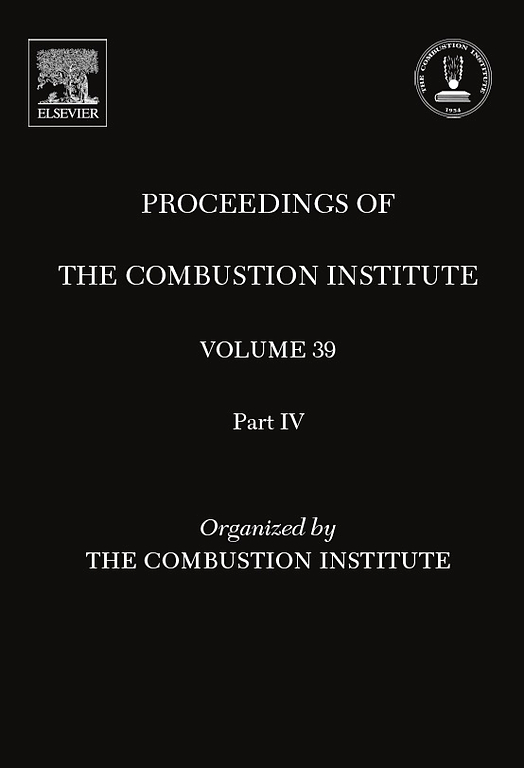Curvature effect on stabilization of cellular detonations in channel, circular arc and spherical shell geometries
IF 5.3
2区 工程技术
Q2 ENERGY & FUELS
引用次数: 0
Abstract
The stability and propagation characteristics of gaseous detonations are numerically investigated, specifically in configurations where global front surface curvature plays a significant role. The simulations use idealized constitutive models representing a weakly unstable mixture and the simulated geometries include both two-dimensional arc and spherical shell sections with rigid walls and a straight channel geometry with compliant confinement. Depending on the inner and outer arc radius, differing levels of curvature can be imparted on the propagating wave in the two curved geometries. For thinner explosive regions, cellular type instabilities develop as the wave propagates around the arc and shell. However, as the thickness of the explosive increases and progressively greater surface curvature is imposed, laminar flow regions develop which can coexist with regions dominated by unstable cellular propagation. Here, the appearance and persistence of this laminar zone is shown to coincide with a critical level of surface curvature for both the arc and shell geometries. This critical curvature concept is also tested in the corresponding straight channel configuration with a compliant confiner, which similarly produces global surface curvature on the propagating detonation front but now as function of imposed wall divergence. Similarly, the propagation in the channel is found to stabilize when the maximum surface curvature exceeds a certain critical value that is close to the analog from the curved geometries. These results support the likely existence of a critical surface curvature mechanism or criterion that ensures the stabilization of a nominally unstable cellular detonation.曲率对通道、圆弧和球壳几何结构中蜂窝引爆稳定的影响
对气体爆炸的稳定性和传播特性进行了数值研究,特别是在全局前表面曲率起重要作用的配置中。模拟使用了代表弱不稳定混合物的理想化构成模型,模拟的几何形状包括具有刚性壁的二维弧形和球形壳体截面,以及具有顺从约束的直通道几何形状。根据内外弧半径的不同,两种弯曲几何形状中传播波的曲率程度也不同。对于较薄的爆炸区域,在波绕弧形和壳体传播时会产生蜂窝式不稳定性。然而,随着爆炸物厚度的增加和表面曲率的逐渐增大,会出现层流区域,这些区域会与不稳定蜂窝传播区域共存。这里显示,层流区的出现和持续与弧形和壳形几何形状的表面曲率临界水平相吻合。这一临界曲率概念也在具有顺应性约束器的相应直通道配置中进行了测试,该配置同样会在传播的爆轰前沿产生全局表面曲率,但现在是外加壁面发散的函数。同样,当最大表面曲率超过某个临界值时,通道中的传播会趋于稳定,该临界值与弯曲几何形状的模拟值接近。这些结果证明了可能存在一种临界表面曲率机制或标准,可确保名义上不稳定的蜂窝状爆炸稳定下来。
本文章由计算机程序翻译,如有差异,请以英文原文为准。
求助全文
约1分钟内获得全文
求助全文
来源期刊

Proceedings of the Combustion Institute
工程技术-工程:化工
CiteScore
7.00
自引率
0.00%
发文量
420
审稿时长
3.0 months
期刊介绍:
The Proceedings of the Combustion Institute contains forefront contributions in fundamentals and applications of combustion science. For more than 50 years, the Combustion Institute has served as the peak international society for dissemination of scientific and technical research in the combustion field. In addition to author submissions, the Proceedings of the Combustion Institute includes the Institute''s prestigious invited strategic and topical reviews that represent indispensable resources for emergent research in the field. All papers are subjected to rigorous peer review.
Research papers and invited topical reviews; Reaction Kinetics; Soot, PAH, and other large molecules; Diagnostics; Laminar Flames; Turbulent Flames; Heterogeneous Combustion; Spray and Droplet Combustion; Detonations, Explosions & Supersonic Combustion; Fire Research; Stationary Combustion Systems; IC Engine and Gas Turbine Combustion; New Technology Concepts
The electronic version of Proceedings of the Combustion Institute contains supplemental material such as reaction mechanisms, illustrating movies, and other data.
 求助内容:
求助内容: 应助结果提醒方式:
应助结果提醒方式:


